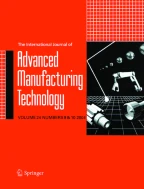Abstract
Resistance spot welding is one of the most important welding procedures. Therefore, a lot of research is done in order to increase its cost effectiveness. One of the problems is short electrode life, especially when coated materials are welded. This paper presents a fuzzy logic-based controller which is capable of detecting expulsion and stopping the welding process when it occurs. Consequently, electrodes are spared of unnecessary high stresses which occur when the energy is being poured into the weld region after expulsion. Their life is therefore substantially increased.
Similar content being viewed by others
References
Podržaj P, Polajnar I, Diaci J, Kariž Z (2008) Overview of resistance spot welding control. Sci Technol Weld Join 13:215–224
Luo Y, Liu J, Xu H, Xiong C, Liu L (2009) Regression modeling and process analysis of resistance spot welding on galvanized steel sheet. Mater Des 30:2547–2555
Goodarzi M, Marashi SPH, Pouranvari M (2009) Dependence of overload performance on weld attributes for resistance spot welded galvanized low carbon steel. J Mater Process Technol 209:4379–4384
Sun X, Stephens EV, Khaleel MA (2008) Effects of fusion zone size and failure mode on peak load and energy absorption of advanced high strength steel spot welds under lap shear loading conditions. Eng Fail Anal 15:356–367
Ruisz J, Biber J, Loipetsberger M (2007) Quality evaluation in resistance spot welding by analysing the weld fingerprint on metal bands by computer vision. Int J Adv Manuf Technol 33:952–960
Zhang P, Zhang H, Chen J, Ma Y (2007) Quality monitoring of resistance spot welding based on electrode displacement characteristics analysis. Front Mech Eng China 2:330–335
Cullen JD, Athi N, Al-Jader M, Johnson P, Al-Shamma AI, Shaw A, El-Rasheed AMA (2008) Multisensor fusion for on line monitoring of the quality of spot welding in automotive industry. Measurement 41:227–234
El-Banna M, Filev D, Chinnam RB (2008) Online qualitative nugget classification by using a linear vector quantization neural network for resistance spot welding. Int J Adv Manuf Technol 36:237–248
Wang H, Zhang Y, Chen G (2009) Resistance spot welding processing monitoring based on electrode displacement curve using moving range chart. Measurement 42:1032–1038
Krause M (1993) Widerstandspreßschweißen, 27. DVS, Düsseldorf
Senkara J, Zhang H, Hu JS (2004) Expulsion prediction in resistance spot welding. Weld J 83:123s–132s
Podržaj P, Polajnar I, Diaci J, Kariž Z (2006) Influence of welding current shape on expulsion and weld strength of resistance spot welds. Sci Technol Weld Join 11:250–254
Ma C, Bhole S D, Chen D L, Lee A, Biro E, Boudreau G (2006) Expulsion monitoring in spot welded advanced high strength automotive steels. Sci Technol Weld Join 11:480–487
Pouranvari M, Abedi A, Marashi P, Goodarzi M (2008) Effect of expulsion on peak load and energy absorption of low carbon steel resistance spot welds. Sci Technol Weld Join 13:39–43
Zou J, Qizhang Z, Zheng C (2009) Surface modified long-life electrode for resistance spot welding of Zn-coated steel. J Mater Process Technol 209:4141–4146
Gould JE, Peterson W (2007) Analytical modelling of electrode wear occurring during resistance spot welding. Sci Technol Weld Join 13:248–253
Rao ZH, Liao SM, Tsai HL, Wang PC, Stevenson R (2009) Mathematical modeling of electrode cooling in resistance spot welding. Weld J 88:111-s–119-s
Latypova EY, Furmanov SM, Tsumarev YA, Emelyanov SN (2008) Modernisation of the cooling systems of resistance spot welding electrodes. Weld Int 22:472–474
Zhang YS, Wang H, Chen GL, Zhang XQ (2007) Monitoring and intelligent control of electrode wear based on a measured electrode displacement curve in resistance spot welding. Meas Sci Technol 18:867–876
Zhang XQ, Chen GL, Zhang YS (2008) On-line evaluation of electrode wear by servo gun in resistance spot welding. Int J Adv Manuf Technol 36:681–688
Lai X, Luo A, Zhang Y, Chen G (2009) Optimal design of electrode cooling system for resistance spot welding with the response surface method. Int J Adv Manuf Technol 41:226–233
Podržaj P, Polajnar I, Diaci J, Kariž Z (2004) Expulsion detection system for resistance spot welding based on a neural network. Meas Sci Technol 15:592–598
Ward D A, Exon J La T (1995) Using Rogowski coils for transient current measurements. Eng Sci Educ J 2:105–113
Weber G (1995) Qualität von Schweißungen und dynamisches Ström–Spanungs–Verhalten beim Widerstandspunktschweißen mit Wechselstrom. Schweiss Schneid 47:23–29
Chen CW (2009) Modeling and control for nonlinear structural systems via a NN-based approach. Expert Syst Appl 36:4765–72
Hsiao FH, Xu SD, Lin CY, Tsai ZR (2008) Robustness design of fuzzy control for nonlinear multiple time-delay large-scale systems via neural-network-based approach. IEEE Trans Syst Man Cybern Part B Cybern 38:244–251
Chen CW, Yeh K, Liu KFR (2009) Adaptive fuzzy sliding mode control for seismically excited bridges with lead rubber bearing isolation. Int J Uncertain Fuzziness Knowl-Based Syst 17:705–727
Yager RP, Filev DP (1994) Essentials of fuzzy modeling and control. Wiley, New York, pp 1–13
Patyra MY, Mlynek DM (1996) Fuzzy logic. Implementation and applications, vol 4. Wiley, Chichester
Terano T, Asai K, Sugeno M (1994) Applied fuzzy systems. AP Professional, Cambridge, pp 36–41
Author information
Authors and Affiliations
Corresponding author
Rights and permissions
About this article
Cite this article
Podržaj, P., Simončič, S. Resistance spot welding control based on fuzzy logic. Int J Adv Manuf Technol 52, 959–967 (2011). https://doi.org/10.1007/s00170-010-2794-0
Received:
Accepted:
Published:
Issue Date:
DOI: https://doi.org/10.1007/s00170-010-2794-0
